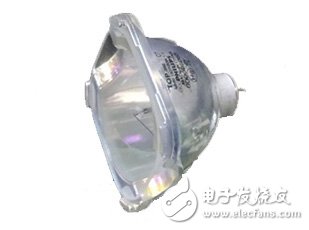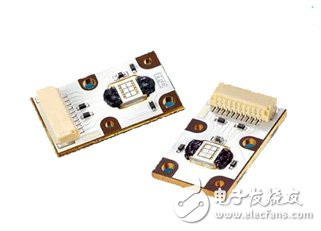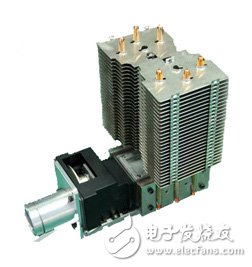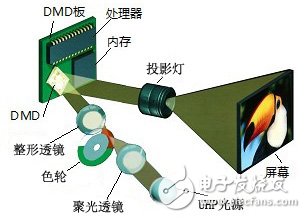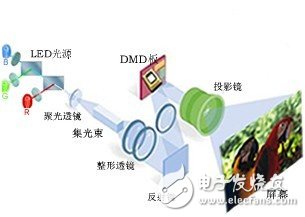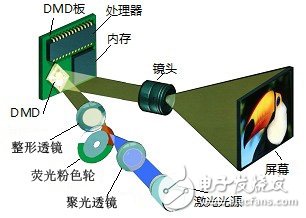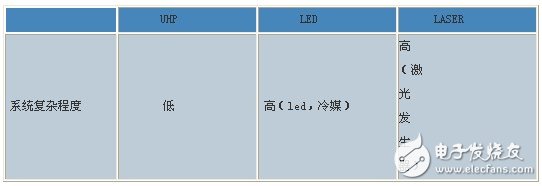DLP (Digital Light Processing) large-screen display system is currently the highest-end technology in the large-screen display industry, providing an irreplaceable product for the real 7*24-hour monitoring needs. First, the importance of light sources in DLP systems In the DLP system, the light source is designed as a replaceable component. Unlike the LCD and the LED, the light source part is a separate subsystem, generally consisting of a light-emitting component, a power component, a heat-dissipating component and a structural component. The light source subsystem is an important subsystem of the DLP system, which has a major impact on DLP products and affects the design of the entire DLP system. 1. The light source determines the quality of the image of the DLP system The selection of the light source determines the important indicators of the DLP system and determines the initial values ​​of the brightness, uniformity, and contrast of the system. As a system for providing light energy for the entire system, it plays a decisive role in the image of the DLP system. 2. The light source determines the stability of the DLP system The light source system generates a large amount of heat and a high temperature, and its stability plays a decisive role in the stability of the entire system. In the early stage of DLP system development, many systems were designed as dual light source systems to ensure the stability of the overall system due to its stability. Almost every early DLP manufacturer has experienced the nightmare of continuous blasting, and has gone through a difficult growth process. 3. The light source determines the maintenance cycle of the DLP product. Due to the characteristics of the light source system, there is inevitably a decay period, and the decay period of each product is relatively uncontrollable. This will result in a significant change in color and brightness after the product has been delivered to the customer for a period of time and requires maintenance. The period of maintenance is determined by the light source and other reasons, where the light source plays a decisive role. 4. The light source determines the maintenance cost of the DLP product As an important part of DLP products, the choice of different light sources will also have different maintenance costs for DLP. Due to the different maturity of the development of the light source technology and the difference in the service life, in the later maintenance, the original device price and the update frequency need to be updated differently, which results in the difference in maintenance cost. Second, the classification of common light sources There are roughly four types of light sources in the DLP system, namely UHP, LED, LASER, and hybrid light source. This article only discusses and compares the first three. 1.UHP light source UHP (Ultra High Performance) light source is the only available light source for DLP systems before 2010. UHP is an ultra-high pressure mercury bulb with a long life, generally 100/120W nominal 8000 hours, the longest even nominal 12000 hours, the brightness will not show significant attenuation after 4000 hours of accumulated working time; 200/250W service life In about 3000 hours. Because the light from UHP bulbs is the ideal cold light source, it is now commonly used in front projection projectors and DLP and LCD (earlier rear projection large screen) rear projection splicing walls. Its main providers are PHILIPS and OSRAM. 2. LED light source The basic structure of LED (Light EmitTIng Diode) is an electroluminescent semiconductor material placed on a leaded shelf and then sealed with epoxy resin to protect the internal core. Therefore, the LED has good seismic performance. . LEDs have been researched and developed since 2004, and have continued to split the market after 2010, currently occupying half of the DLP system. Its main providers are OSRAM and LUMENUS. 3.LASER light source The LASER light source is an electric light source that emits light under the action of excited radiation by an excited state particle, and is a coherent light source. The LASER light source system began development in 2008 and began to split the market in 2011. It is more used in high-brightness positive projections such as digital cinema in DLP display systems. In 2012, it entered the DLP splicing system. Its main provider is NICHIA and others. 4. Mixed light source (not detailed) Hybrid light source system, this paper is considered to be a supplement to the LED light source, mainly to solve the problem of insufficient brightness of the green light of the LED light source. In 2011, LED (R\B)+LASER (G) products began to appear. Third, the introduction of the working principle of various types of light sources 1.UHP light source works The UHP light source is an ultra-high pressure mercury lamp, which is started by a high-voltage breakdown arc of 20KV, generally using a fan as its heat dissipation method. The UHP source emits white light through the transmission color wheel to produce a color whose color gamut depends on the color distribution of the color wheel. For the sake of brightness, white parts are generally added to the color wheel to increase the brightness of white, but at the same time, the distribution of color gamut is reduced. UHP light source has been used for more than 15 years, and the technology is mature and reliable. Due to the home appliance of some products, the cost is relatively low. The UHP patent is controlled by PHILIPS and may develop to an average life of 20,000 hours in the future. UHP light source working principle diagram 2. How LED light source works LED is a light-emitting diode, which is a semiconductor solid-state light-emitting device, and generally uses a refrigerant as a main method of heat dissipation. Since there are LED lights of different colors of red, green and blue, the LED light source system does not require a color wheel. However, due to insufficient brightness, multiple colors of the same color are currently required to work as three sets of lamps. The brightness of the LED light source cannot be improved in the early stage, and the green light is the brightness bottleneck. At present, DLP products equipped with OSRAM LED light source can reach a typical value of 1000lm, and a single product can be selected to reach 1200lm, which basically solves the brightness problem. However, due to the multi-color and multi-distribution, the attenuation of multiple LED light sources is uncontrollable. At present, the color drift is more dependent on the product design capabilities of various manufacturers. LED light source working principle diagram 3. LASER laser source works LASER is a laser light source. The system consisting of red, green and blue three-color lasers is too large and the price is amazing. It is currently used in front projection equipment such as digital cinema. What we are introducing here is that the blue laser is emitted by the laser generator, and the red, green and blue colors are changed by the fluorescent pink wheel. Some manufacturers use the laser plus fluorescent pink wheel system as the LPD (Laser Phosphor Display) system. Currently, the products used in the splicing system are mostly systems with fluorescent pink wheels. It is generally believed that the average life of a laser generator is 40,000 hours, but there is no accurate estimate of the life of a fluorescent pink wheel. The system is similar to the UHP light source system. Schematic diagram of the working principle of laser light source Fourth, the description of the reliability of the light source There are many factors that can affect the reliability of the light source. It is not that the average life of the LED light source will be longer, and it depends more on the design of the entire system. There are several factors that affect the life of a light source: Temperature and humidity Regardless of the source of light, the temperature and humidity requirements are the first. The influence of temperature and humidity on the life of the lamp is decisive. Regardless of the UHP lamp or the current LED lamp, lowering the temperature is the biggest problem for every designer. For every 10 degrees increase in temperature, the life of the light source is reduced by half. An increase in humidity also reduces the life of the light source. 2. Current and voltage After the UHP lamp is triggered, it can ensure stable voltage and current, and will not change with the external voltage. However, in the early stage of the UHP lamp's insufficient brightness, some manufacturers will adjust the output current to make their products appear. brighter. In the case that the brightness of the LED lamp cannot be guaranteed, some manufacturers have OVERLAP 25% to improve the brightness of the product, and more manufacturers have OVERLAP 30%, and the consequence is necessarily a decrease in life. 3. Dust and corrosion Dust and corrosion are related to the environment and the microenvironment in which the product is designed. Of course, dust is fatal to the entire DLP system. At present, manufacturers use various dust-proof systems to reduce the effects of dust and chemical corrosion. Of course, when the design contradiction between cooling and dustproof is put together, the design difficulty is very large. 4. Other The thermal deformation of the mechanical structure and the design of the optical path also affect the reliability of the light source. Five, the advantages and disadvantages of various types of light sources 1. Brightness contrast In terms of brightness contrast, LASER is the highest, UHP can be used in the form of dual-lamp stacking, and can also provide 1600lm brightness, in this PK, LED can not win. Since the brightness of various light sources is basically sufficient, we give UHP, LED and LASER 9 points, 8 points and 10 points respectively. 2. Average life comparison The average life is defined as the brightness of 50% of the light source remaining above 50% of its rated brightness when operating to the above rated life. The life of the UHP light source is still struggling to improve (the subsequent 20,000 hours), the stability of the LED light-emitting diode has been recognized, the brightness of the LASER light source is currently unverifiable due to the life of its fluorescent pink wheel, temporarily set to 40,000 hours. This round of battle, LED light source won. We give UHP, LED, LASER 5 points, 10 points and 8 points respectively. 3. Reliability comparison The LED light source has no color wheel and reduces an optical part. The COLOR WHEEL acts as a rotating machine and is rotated by the motor. The MTBF is 20,000 hours. The color wheel is the smallest part of the MTBF in the DLP system, and the impact on reliability is enormous. The general color wheel appears in consumables in the DLP system. Both the UHP source and the LASER source have color wheels, and the LED source reduces one consumable part. Still LED light source wins. We give UHP, LED, and LASER 9 points, 10 points, and 7 points respectively. 4. Maintenance cycle comparison UHP light source and LASER light source (LPD) are a set of light sources. The attenuation and color coordinate changes depend on a single part. The LED light source consists of three different sets of color light. There are six lights in each group, and the attenuation of different color lights. The degree cannot be the same, causing the color to drift too much and must be adjusted after a certain period of time. The above data is provided by the Multimedia Technology Engineering Service Department, and the maintenance time of the LASER light source is not confirmed. This round of UHP won, but did not achieve the maintenance-free ideal, we give UHP, LED, LASER 5 points, 3 points and 4 points respectively 5. Price comparison The UHP light source has improved over the past 15 years, the technology is very mature, there are fewer products to be updated on the system, and the price of LED light source and laser generator is still high. The lens price of the LED tri-color source is much higher than the price of a color wheel, and the refrigerant cooling system is not expensive. Users using new products must share the cost of research and development. Among them, the laser light source can borrow the platform of the original UHP light source, and the price has a certain advantage over the LED light source. UHP wins in price. We scored 10, 7, and 8 points for UHP, LED, and LASER. 6. Summary Based on the above, we look at the following table to report the scores of various light sources on the above five items. 300w FM Transmitter equipment has a trigger signaltonoise ratio and low power consumption. Fm radio transmitter that can be used for factories, schools, supermarkets, farms, office space or create your own bad situation. And this fm radio transmitter that can be used for automatic detection of local wireless signals, easy to operate, and quiet. Fm radio transmitters are used to receive radio signals, so you have the stations in the car or on a boat. At the same time, this fm radio transmitter is a special handheld device that can be used to receive the signals in your car or home. 300W Fm Transmitter,300W Broadcast Transmitter,300W Audio Transmitter,300W Fm Broadcast Transmitter Anshan Yuexing Technology Electronics Co., LTD , https://www.yxhtfmtv.com